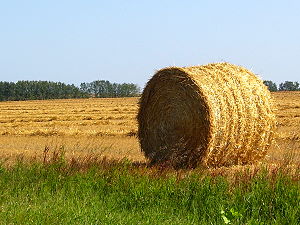 Northwest Region Crop Report Prepared by: Manitoba Agriculture
Northwest Region Crop Report Prepared by: Manitoba Agriculture
November 12, 2019 |
Northwest Region
The 2019 harvest is near completion with the exception a few acres where snow halted operations. Most areas of the Northwest region are snow covered at this point. The red spring wheat harvest is generally complete in the region with average yield for hard red spring wheat is 50 to 75 bu/ac. Grades range with 25% of the crop grading #1 CW, 50% grading #2 CW and the remainder grading lower. Grades appear to be lower than average this year with the inclusion of falling numbers. The canola harvest is virtually complete with approximately 99% of the acres combined. Canola yields averaged 50 to 60 bu/ac. The quality of canola harvested is standard for the region with 90% of the crop grading #1 CAN and the balance #2 CAN. Field pea harvest operations are complete with yields averaging 40 to 80 bu/ac and grading #2 CAN in the Swan River and Roblin areas. Soybeans are 99% complete with yields averaging 35 to 40 bu/ac; 80% of the crop is grading #2 CAN.
The 2019 growing season was a challenge through most of the region, largely due to precipitation and dry soil moisture. In the spring, soil moisture was adequate for most of the region. The exceptions were areas around Ste. Rose/Rorketon where dry conditions from 2018 continued. Soil was wet at The Pas, also from the 2018 season. Before the 2019 cropping season could even begin, the crop left out from 2018 needed to harvested and field operations completed around Swan River, The Pas and Dauphin.
Seeding was well underway by midMay although conditions were challenging due to dry soils causing germination issues as well as cool overnight temperatures and frosts. There was some reseeding due to frost around Swan River and Roblin areas. Hot weather as well as ongoing lack of precipitation continued and affected germination and crop establishment through to mid-June. Some areas in the region did receive rain however, the drier areas received the least amount of precipitation. These conditions continued throughout the growing season. Part way through the season, periodic heavy downpours through the Roblin and Swan River areas replenished soil moisture while conditions remained dry around Dauphin and Ste. Rose. There were hailstorms this season around Roblin, Swan and Ste. Rose at various times during the summer with damage ranging from minimal to significant. Hot, dry conditions caused some pod abortion during flowering on canola; however, yields and quality did not seem to be affected a significant amount. As the season progressed, crops in the region recovered to some extent, but issues with germination, emergence, frost, insects and dry soil conditions became visible and caused staginess in the crop. This variety of staging became a challenge for harvest.
As far as insects in the region in 2019, flea beetles continue to be an issue in emerging canola; there were diamondback moth larvae observed in fields around Swan River; bertha armyworm moth trap count numbers were in the uncertain range in traps around Swan River, Ste. Rose and Ethelbert and thistle caterpillars were observed on soybeans. The variable moisture caused rapid changes to the fusarium risk map for the region however, for the most part, the dry season did reduce disease pressure. Producers were able to limit the impact of disease and insect pressure due to timely and appropriate application of fungicides and insecticides to susceptible crops at the most beneficial stage. Some anhydrous ammonia has been applied as harvest and field conditions allowed.
There was frost in Swan River in early September and Roblin had frost the end of September, however; the entire region had a killing frost the first week of October. With the exception of The Pas, there was a heavy snowfall the beginning of October as well. Cool weather continued with intermittent snow and rain showers causing challenges and extending harvest operations well into late October with some harvest operations taking place in November. Currently soil moisture conditions rated as average with areas on the western side of the region remaining dry. Although challenged with a wet snowy fall, much of the fall fieldwork is complete and fields are prepared for spring operations. Most fields in the northwest region are snow covered at this point.
In the Ethelbert, Sifton, Winnipegosis, Rorketon, Eddystone, Ste. Rose and Alonsa areas pasture and forage fields are rated as 99% in poor condition, with re-grazing taking place after the fall green-up. Pasture moisture conditions are rated as 50% adequate, 50% short. Hayfields have absorbed most of the available precipitation that fell in October, with 20 to 30% second cut being harvested. Winter feed stocks for hay are rated as 30% adequate; for greenfeed and feed grain are 50% adequate, and 40% adequate or 60% inadequate for straw stocks. Corn silage harvest continues in
these same areas with much of it being too dry now. Yields are reporting coming off at 13 to 20 tonnes/ac. High nitrates in annuals continue to be a major concern.
In the Swan River and Roblin area, throughout the grazing season, pastures were in fair to good condition but had seen more overgrazing through August and September. For the most part, going into the fall, pasture moisture conditions were adequate. For winter feed supplies, there is an adequate supply of straw and feed grains. Greenfeed yields were average; however, producers struggled to harvest late seeded crops due to poor drying conditions this fall. Producers that rely on alfalfa grass hay based rations will need to source additional feed due to lower first cut hay yields and a minimal second cut taken. Corn silage harvest in this area was completed in October with average yields being reported.
